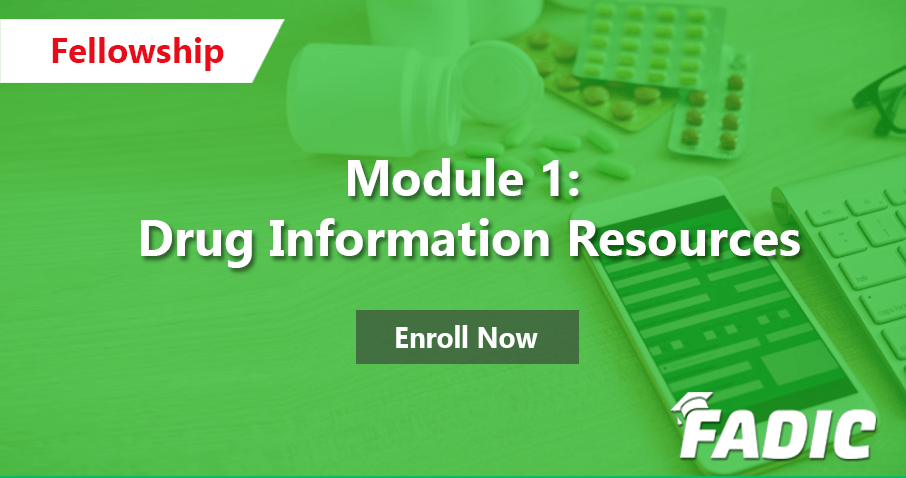
Overview
Overview
Module 1: Drug Information Resources

Sessions Objectives
1. Introduction and history of Drug Information
- Define the drug information concepts and basics.
- Illustrate the history of drug information globally.
- Review the traditional pharmacy definition before and now.
- Explain FADIC scientific goals of drug information
- Understand how to maintain drug information between different organizations.
2. How to formulate an answerable question?
- Describe the importance of drug information centers in the evolution of pharmacy practice.
- Define Evidence Based Medicine.
- Learn how to formulate a Clinical Question using PICO Format.
- Describe the skills needed by pharmacists to perform medication information functions
3. Systematic | Structural Approach for Answering a Drug Information Request
- You will be able to know the difference between the systematic approach and the modified systematic approach
- The 7 steps involved in the modified systematic approach.
- Use the modified systematic approach in answering drug information questions
- The ability to effectively answer questions posed by health care professionals and the lay public
4. Drug Information, and Electronic Resources
- Understand different types of the resources
- Determine the difference between different types of the resources
- List important types of resources, for the professionals, and for the consumers
- Discuss different medical and pharmacy resources.
5. Descriptive and Inferential Statistics
- Describe different types of statistics.
- Understand the Visual Methods of Describing Data
- Explain the nnumerical methods of describing data: Measures of central tendency
- Define the numerical methods of describing data: Measures of Data Spread or Variability
6. Clinical Application of Biostatistics
- Describe the importance of understanding statistics in completing and evaluating scientific studies.
- Define the various levels of data.
- Determine whether the appropriate statistics have been performed and provided in a study.
- Interpret the statistical results provided in a research study to determine whether the authors’ conclusions are supported
7. Controlled Clinical Trial Evaluation and Phases
- Explain reasons why pharmacists need the skills to locate and
- Evaluate current information for pharmaceutical care activities.
- Describe the special characteristics of clinical trial that distinguish this research design for clinical research.
- Identify Internet websites to register controlled clinical trials
- Discuss methods to identify the potential, and conclusions.
- Differentiate between internal and external validity.
- Identify key information presented in sections of a clinical trial.
- Discuss needs for well-defined study objective, randomization, and blinding within a clinical trial.
8. Journal Review & Journal Club Presentation
- State the guidelines for reviewing a journal article.
- List the important aspects when examining a manuscript and write the review.
- List of components of both a research and review paper.
- Describe the standard format of the journal articles.
- Discuss the results of the study and clearly specify the limitation.
- Describe how to prepare a review article.
- Describe how to correctly cite an article in a bibliography.
- State author guidelines for publications in journals.
Duration: 8 Weeks
Curriculum
-
Drug Information Fellowship Navigation Guide
- How to Effectively Learn this Course?
-
W1- Introduction and history of Drug Information
- 1.1. Introduction of Drug Information (Video 54:42)
- 1.2. Workshop 1 – Module 1 (Quiz 60:00)
-
W2- How to formulate an answerable question?
- 2.1. How to formulate an answerable question? (Video 01:09:13)
- 2.2. Workshop 2 – Module 1 (Quiz 60:00)
-
W3- Systematic | Structural Approach for Answering a Drug Information Request
- 3.1. Systematic Approach Drug Information Request (Video 45:10)
- 3.2. Workshop 3 – Module 1 (Quiz 60:00)
-
W4- Drug Information, and Electronic Resources
- 4.1. Drug Information Electronic Resources (Video 42:38)
- 4.2. Workshop 4 – Module 1 (Quiz 60:00)
-
W5- Descriptive and Inferential Statistics
- 5.1. Introduction of Biostatistics (Video 27:51)
- 5.2. Types of Data (Video 19:16)
- 5.3. Descriptive and Inferential Statistics (Video 26:55)
- 5.4. Population Distribution (Video 22:38)
- 5.5. Types of Statistical Errors (Video 30:05)
- 5.6. Statistical Hypothesis Testing (Article)
- 5.6. Statistical Tests Case Studies (Video 23:23)
- 5.8. Statistical Significance (Video 29:10)
- 5.10. Workshop 5 – Module 1 (Quiz 60:00)
-
W6- Clinical Application of Biostatistics
- 6.1. Correlation and Regression (Video 22:27)
- 6.2. Survival Analysis (Video 12:15)
- 6.3. Biostatistics and Research (Video 16:51)
- 5.4. Biostatistics Cases (Video 17:55)
- 5.5. Application of Biostatistics (Video 30:50)
- 5.6. Graphs Used in Biostatistics (Video 24:26)
- 5.7. Biostatistics Resources (Video 12:50)
- 5.8. Workshop 6 – Module 1 (Quiz 60:00)
-
W7- Controlled Clinical Trial Evaluation and Phases
- 7.1. Introduction of Clinical Trial (Video 08:41)
- 7.2. Literature Evaluation (Video 20:06)
- 7.3. Content of Clinical Trials (Video 26:41)
- 7.4. Experimental Study Design (Video 07:44)
- 7.5. Internal & External Validity (Video 09:59)
- 7.6. Biases and Confounding (Video 08:11)
- 7.7. Incidence & Prevalence (Video 11:38)
- 7.8. Top 10 Clinical Trial Websites (Video 08:28)
- 7.9. Phases of Clinical Trials (Video 15:42)
- 7.10. Phase 4 and Conclusion (Video 22:05)
-
W8- Journal Review & Journal Club Presentation
- 8.1. Journal Review (Video 2:08:38)
-
W9- Final Project of Module 1
- 9.1. Final Project of Module 1 (Quiz 60:00)
Features

 Log in
Log in Sign up
Sign up

